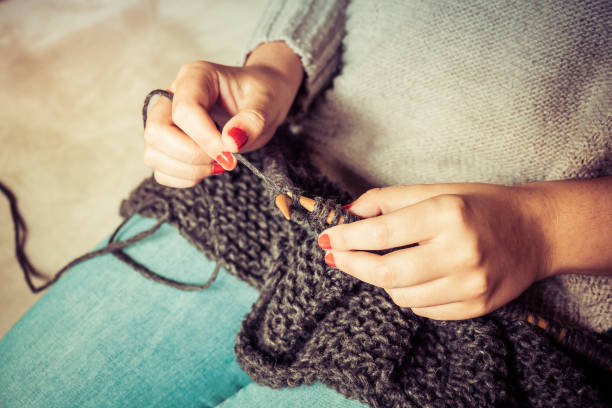
Its popularity is due to its portability and practicality, and it is proof that knitting is good for your mental health and can be used as a form of relaxation and meditation.
Many people associate knitting with home comforts and stability. Knitting (and other crafts) are becoming increasingly popular among people who live in isolation. They use them to pass the time and to block out the COVID-19 crisis news.
Even US sailors, marines, and soldiers deployed to the Persian Gulf started a knitting group to cope with the stress of being stuck in US Bataan because of COVID-19.
The first Cast
Hand knitting is not known to have its origins. However, in Israel, there are surviving examples dating back over 8,500 years of a single needle technique that was called nalbinding during the 1970s.
Around 600 CE, the ancient Egyptians began using single-needle knitting to create socks.
Between 793 and 1066 CE, Nalbinding became popular in Europe, especially among the Vikings, who used it to make durable, useful garments. It was a method that could be easily transported and worked well.
Early knitting needles were made of wood, antler, and bone. By 1100 CE, knitting had spread to North Africa and Europe and evolved into the looping-and-knotting technique that we use today. The word “knitting” is likely derived from the Dutch “knutten”, a derivative of the Old English verb, cnyttan. Both words mean “to knot”.
The 1300s saw the introduction of many knitting techniques we use today. By the 15th century, the use of four and five needles to knit a seamless tubular garment was widespread.
The two-stick knitting method can be used to knit any yarn. People knitted luxurious garments, including jackets, using silk, linen, and cotton.
Museum collections contain examples of intricate hand-knitting, such as socks, vests, and caps, dating from the 12th-17th centuries. These items show not only the high level of craftsmanship but also the evolution of the activity of knitting into a highly skilled, highly valued one.
The invention of the first mechanical knit machine in 1589 led to the early demise of commercial hand knitting. Hand knitting was a skill that survived the Industrial Revolution and became a pastime of wealthy women in the 18th century.
In the 19th century, knitted clothing was still highly prized because it could not be produced on machines.
Hand knitting was popular throughout the 20th century. This is due in part to the mass production of garments such as jumpers and socks for soldiers who fought in both world wars. People knitted thousands of pouches to help animals that were injured by the bushfires in Australia.
Beginner’s tips
Knitting is a simple skill to master. There are many tutorials available to get you started.
It can be frustrating to learn how to knit with fine yarn on small needles if you are a beginner. If you are not familiar with smaller needles or threads, they can be difficult to control. You can master knitting using chunky yarn and larger needles.
Three basic techniques are cast-on, plain stitch(also called knit stitch), and Cast off. You can knit a scarf with ease if you know how to do three simple things.
You can learn to read a pattern as you gain confidence in knitting. Try your hand at a simple beanie or a simple jumper.
Joining an online community such as Ravelry will put you in contact with other knitters who share your passion, provide you with beautiful patterns and tips, and encourage you to explore different yarns.
Start with a scarf.
This Simple, chunky knitting scarf is an excellent beginner project. It can be made with any color you choose.
You’ll need:
- Knitting Needles – 13mm or 9mm
- Yarn Super Bulky – 6
- Gauge – 9 stitches = 4 inches
- The finished size is 180cm, or however long you want.
Key:
K = knit
KF&B = Knit the front and back to increase
K2tog is the term used to knit two stitches together.
Instructions:
- Cast on 2 Stitches (2)
- Row 1: KF&B1, K1 (3)
- Row 2: KF&B2, K2 (4)
- Rows 3-11: Increase one at the start of each row until you reach 12 stitches.
- Continue knitting the scarf until it reaches the desired length.
- Start by creating the endpoint.
- K2tog 1, K at the end (11)
- K2tog 1, then K to the end (10)
- Continue to work until there is only one stitch remaining on the needle. Cut the yarn, and then pull it through so that you can make a knot.
Then, add some cute pompoms on the ends. It’s cozy times, and you get kudos.
